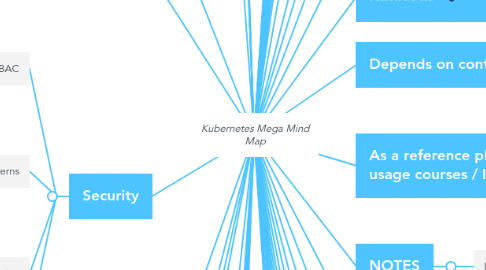
1. Registry
2. Building a PaaS for developers
3. Schedulers
4. Etc
5. API Reference
6. Deployments
7. Design
7.1. Labels
7.1.1. Selectors
7.2. Concepts
7.2.1. Service discovery
7.2.2. Namespaces
7.2.3. Self healing
7.2.3.1. declarative health checks in Pod template
7.2.4. REST Resources
7.2.4.1. represent all the things
7.2.4.1.1. Pods
7.2.4.1.2. Services
7.2.4.1.3. Ingress
7.2.4.1.4. Nodes
7.2.4.1.5. Configmaps
7.2.4.1.6. Deployments
7.2.4.1.7. DaemonSet
7.2.4.1.8. StatefulSet
7.2.4.1.9. ReplicationControllers
7.2.4.1.10. PersistentVolumeClaims
7.2.4.1.11. Secrets
7.2.4.1.12. NetworkPolicy
7.2.4.1.13. Job
7.2.4.1.14. CustomResourceDefinition
7.2.5. Federation
7.2.5.1. make workload placement decisions
7.2.5.2. curl http://127.0.0.1:8080
7.2.5.2.1. Etcd
7.2.5.2.2. take actions
7.2.6. Controllers
7.3. kube-apiserver
7.3.1. REST API
7.3.1.1. watch for events
7.3.1.2. Swagger 2.0
7.4. Admission Controllers
7.4.1. Moving to OpenAPI
7.5. Worker
7.5.1. kubelet
7.5.2. containers
7.5.2.1. iptables
7.5.3. kube-proxy
7.5.3.1. storage
7.6. kube-scheduler
7.7. Components
7.7.1. Master
7.7.2. Hyperkube
7.7.3. kube-controller-manager
7.7.4. kubectl
7.7.4.1. KUBECONFIG
7.8. ServiceAccounts
7.9. Covering the whole delivery landscape
7.10. Architecture
7.10.1. Dashboard
7.10.2. Multi-master
7.10.3. Addon Manager
7.10.4. Addons
7.10.4.1. kubeadm
7.10.4.2. DNS
7.10.4.2.1. Heapster
7.10.4.3. Ingress
7.10.5. Access to academy of case studies, solutions, how-to's, etc.
7.11. Heapster
7.12. RBAC
7.12.1. Certifications
7.12.2. ClusterRoleBinding
7.12.3. ClusterRole
7.12.4. Role
7.12.5. RoleBinding
7.13. Metrics
7.13.1. Whiskless
8. Service Discovery
9. Storage
9.1. StorageClasses
9.1.1. AzureFile
9.1.2. RBD
9.1.3. etc
10. Security
10.1. ABAC
10.2. Runtime Patterns
10.2.1. Systemd
10.2.2. As containers
10.2.2.1. Minikube
10.2.2.2. ACS
10.2.3. AzureDisk
10.3. Key generation and rotation
10.4. Borg and Omega
11. App Architectures
11.1. Twelve-Factor
11.2. 3-tier
11.3. Monolith
11.3.1. Microservices
12. PersistentVolumes
13. Rook
14. Flannel
15. Kubernetes
15.1. Workloads
15.2. History
15.3. Frameworks
15.4. templated deployments
15.5. Serverless
15.6. Documentation
15.6.1. How to find help
15.6.2. Resource Reference
15.7. Tools
15.7.1. Helm
15.8. Clouds
15.8.1. Draft
15.9. Container as a Service (CaaS)
15.9.1. Azure ACS
15.9.2. GKE
15.9.3. Bluemix
15.10. Kargo
15.10.1. kube-aws
15.10.2. Mircroservices
15.10.2.1. Istio
15.10.2.2. Linkerd
15.11. Distros
15.11.1. Kops
15.11.2. Minikube
15.12. PaaS
15.12.1. Openshift
15.12.2. Minishift
16. What makes our courses different?
16.1. Beautiful design
16.2. Extensive use of visuals
16.3. Practical skills that a practitioner can use to deliver work for a client immediately
16.3.1. Certified Kubernetes Administrator (CNCF exam)
16.4. Holistic
16.4.1. Live and offline access to industry professionals
17. Patterns
17.1. Operator
17.1.1. Prometheus
17.1.2. PostgreSQL
17.1.3. Etcd
18. Operators for automating operational knowledge
19. Plugin architecture
19.1. SDN
19.1.1. Calico
19.1.2. Weave
19.2. SDS
19.3. CNI
19.4. CRI
20. Blue / Green
21. /metics Prometheus endpoint
22. Use of motion graphics to explain difficult topics
22.1. Potentially use Open Datacentre?
22.1.1. for the labs
22.1.1.1. Common patterns of usage
23. Cluster deployment Patterns
23.1. Systemd
23.1.1. Container manager Hyperkube
23.2. Curated learning resources for Developers and Operators
23.2.1. Identify info that is still current and of high quality
24. Cloud provided storage
25. Topics
25.1. Containers
25.1.1. Components
25.1.1.1. cgroups
25.1.1.2. namespaces
25.1.1.3. overlay filesystem
25.1.2. Docker
25.1.2.1. simple CLI
25.1.2.1.1. Workload distribution
25.1.3. Registries
25.1.4. Developer Workflow
25.1.5. Multi-node
25.1.6. The need for Container Orchestrators
25.2. Deployments
25.2.1. Rolling
25.2.1.1. pause
25.2.1.2. resume
25.2.1.3. undo
25.2.1.4. history
25.2.1.5. Packaging
25.2.2. Replace
26. Testing
27. Metrics and Alerting
28. GCEpersistentDisk
29. Like SAP do
30. Using k8s as a PaaS
31. Real world learning
32. Online exercises
33. Distributed Systems
33.1. Resource limits
34. Crashcourse
35. Kubernetes
36. Using CNCF projects
37. Monitoring / Alerting
38. Building the solution
38.1. Specific workloads / solutions designed for the particular courses
39. Complex real world application patterns
39.1. Practical Usage
39.1.1. 2 hours
39.1.2. Security
39.1.2.1. Hyper-converged
39.1.2.1.1. OpenEBS
39.1.2.1.2. NFS
39.1.3. Storage
39.1.4. CI/CD
39.1.4.1. Development
39.1.4.1.1. Operator Focussed Stream
39.1.5. Opinionated guide to being productive
40. YouTube videos
41. Networking
42. CI/CD
43. Mentoring
44. Katacoda
45. Depends on content
46. As a reference platform for the practical usage courses / labs
46.1. KDL notation
46.2. Overview
46.3. Architecture
47. NOTES
47.1. Developer Focussed Stream
48. Not just academic
49. Fluentd
50. Custom
51. 1 Day
52. Advanced
52.1. 2 Days
52.1.1. Machine Learning
53. Learning is relevant to real needs in the workplace
54. Logging
55. CI / CD
56. Courses
56.1. Fundamentals
57. Themes
58. Labs
59. Research
60. Materials
60.1. Manuals
60.1.1. Diagrams created using KDL notation
61. Differentiators
62. Knowledge Domains
62.1. Tracing
62.2. Logging
62.3. How it fits with the other solutions
62.4. Orchestration
62.5. Security
62.5.1. Microservices
62.5.1.1. Cloud Native Applications
63. Patterns
63.1. Sidecar
63.2. Ambassador
64. CNCF
64.1. Storage
64.2. Projects
64.2.1. Prometheus
64.2.2. Etcd

